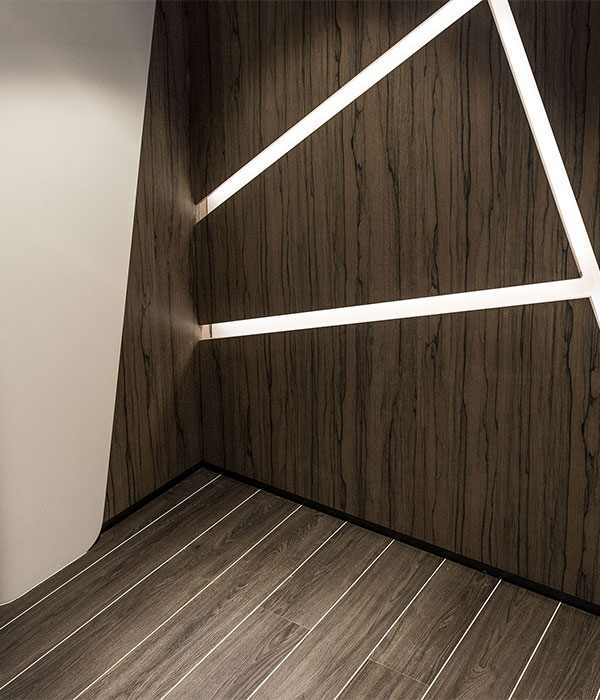The choice of surface materials is one of the most important decisions a designer can make, affecting the functionality, aesthetics and durability of a space. Composite materials have become an increasingly popular choice for a wide range of applications due to their versatile properties. But what should you consider when choosing composite for a project? This checklist will help you make an informed decision and find just the right solution for every project.
What are the characteristics of a good quality composite?
A high-quality composite material is much more than just a good-looking surface. It must meet a number of technical and aesthetic requirements to serve its purpose for years to come. Sustainability is one of the most important properties, as the surface material must be able to withstand daily wear and tear, impacts and scratches.
Heat resistance is an essential property, especially in kitchen and bathroom environments. A good composite can withstand temperatures of up to 180-200 degrees Celsius at times, making it a safe choice even in the vicinity of hot objects.
Hygiene is emphasised in public areas and on surfaces in contact with food. High-quality composite is non-porous, preventing bacteria from being absorbed into the material. This property makes it Kerrock composite panels products are an excellent choice for kitchens and hospital environments.
Adaptability and seamlessness are particularly valuable features from a designer's point of view. Composite can be worked like wood, allowing for individual shapes and details. Seamless joints, on the other hand, create a uniform surface that is easy to clean.
The range of colours and textures is often extensive, giving designers the freedom to realise their vision. Modern composite products and surface materials offer options from matt to glossy and a variety of patterns.
For which applications is composite best suited?
The versatility of composites is reflected in their suitability for a wide range of applications. Kitchen worktops are one of the most typical applications, as the material is highly resistant to moisture, heat and intensive use. In addition, composite sinks can be seamlessly integrated into the worktop, creating a stylish and easy-to-clean ensemble.
In bathrooms, composite offers a moisture-resistant and safe alternative. Anti-slip surface options increase safety, and the malleability of the material allows ergonomic solutions.
In public spaces, the emphasis is on wear resistance and hygiene. Hotels, restaurants and healthcare facilities benefit from the easy cleanability of composite and the ability to create seamless surfaces.
In specific applications, such as laboratories, the chemical resistance of the composite is a major advantage. The material does not react with most chemicals, making it a safe choice for demanding environments.
Comparison of composite with other surface materials
| Material from | Benefits | Challenges |
|---|---|---|
| Composite | Seamless, malleable, hygienic, repairable | Price, requires professional installation |
| Natural stone | Natural beauty, sustainable | Porous, requires regular maintenance, heavier |
| Laminate | Affordable, wide range of colours | Less durable, visible seams |
| Wood | A warm, natural look | Scratches easily, sensitive to moisture |
Compared to natural stone, composite is lighter and easier to work with, even after installation. Unlike stone, composite does not require regular surface protection. Repairability is a major advantage, as most damage can be sanded and polished away.
Compared to laminate, composite offers a longer-lasting and higher quality option. While laminate is often less expensive, composite typically has a much longer lifespan, making it cost-effective in the long term.
Compared to wooden surfaces, composite is much more resistant to moisture and requires less maintenance. On the other hand, wood provides a natural warmth that composite can lack.
Composite maintenance and servicing
One of the biggest advantages of composite is its ease of maintenance. Water and mild soap are usually sufficient for daily cleaning. For removing stubborn stains, a non-abrasive cleaner and a soft cloth can be used.
Although composite is scratch-resistant, it is advisable to use a cutting board when handling sharp objects. It is advisable to place a pan cloth under hot dishes, even if the material can withstand a momentary heat load.
Small scratches and marks can often be removed by sanding and re-polishing the surface. This is significant advantage the lifetime of the composite, as the material can be renewed without replacing the entire surface.
Avoid abrasive cleaning products and tools, as well as harsh chemicals such as acetone or solvents that can damage the surface. Regular maintenance will ensure that the composite surface retains its appearance and functionality for years.
Environmental considerations in the choice of composite
As environmental awareness grows, the ecology of material choices is also becoming more important in design. The environmental impact of composite materials varies by manufacturer and product, but many manufacturers have developed their products in a more sustainable direction.
The principles of the circular economy are at their best when composite panels can often be recycled and used as raw material for new products. Always check the information provided by the manufacturer on the recyclability of the material and the environmental impact of the manufacturing process.
A long lifetime is a major environmental benefit. A durable material that does not need to be replaced frequently reduces waste and the need for new resources. So by choosing a high quality composite, you can also make a more ecologically sustainable choice.
Look for products with recognised environmental certifications and low VOC (volatile organic compound) emissions. These are signs of a manufacturer's commitment to greener practices.
In a design project, choosing a composite is a balancing act between technical properties, aesthetics, budget and environmental impact. We offer a wide range of high quality composite panels for different needs and will help you find the best option for your project. See our previous composite implementations and references, so we can work together to identify your needs and find the best solution.

